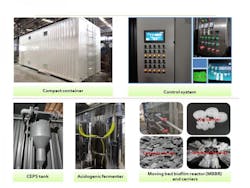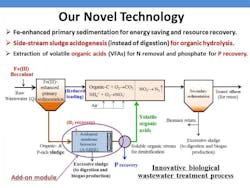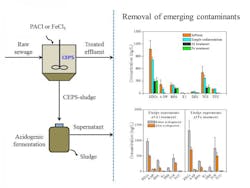University of Hong Kong team develops new wastewater treatment process
HONG KONG, MARCH 31, 2020 -- Globally, there is a growing concern regarding the presence of trace emerging contaminants such as retinoids and oestrogenic endocrine disrupting chemicals (EDCs) in aquatic environments. Retinoids such as retinoic acids and their metabolites, which are the derivatives of vitamin A, can cause abnormal morphological development in amphibians, fish, and snails at elevated levels. Oestrogenic EDCs like alkylphenols and bisphenol A are environmental oestrogens that can induce feminization of male fish and abnormal development in aquatic organisms.
Sewage effluents are a significant source for the continuous input of these contaminants into the aquatic environment. High levels of these chemical contaminants are commonly found in sewage effluents discharged from conventional sewage treatment plants (STPs).
An interdisciplinary team led by the University of Hong Kong (HKU) has developed a novel wastewater treatment system that can effectively remove conventional pollutants, and recover valuable resources such as phosphorus and organic materials (i.e., carbon fibers and volatile organic acids).
This novel system combines chemically enhanced primary sedimentation (CEPS) of sewage with acidogenic fermentation of sludge in tandem (Image 1). A series of laboratory experiments were conducted to prove that this novel system can effectively remove trace emerging chemical contaminants from wastewater and is more cost effective compared with conventional wastewater treatment systems.
Moreover, in collaboration with the Nanshan Sewage Treatment Plant in Shenzhen, a pilot wastewater treatment system adopting the novel treatment process has been under construction in Shenzhen since 2019. It will come into operation and testing by this summer if the COVID-19 outbreak subsides.
Background
In the past few years, Professor Xiao-Yan Li of the Department of Civil Engineering who led the interdisciplinary research project, has been collaborating with Professor Kenneth Leung from HKU School of Biological Sciences and the Swire Institute of Marine Science to examine the levels and removal efficiencies of retinoids and oestrogenic EDCs from wastewater by the novel wastewater treatment process developed by the research team, and to compare that with the conventional STPs.
The research team first examined the levels and removal efficiencies of retinoids and oestrogenic EDCs in Shatin, Stanley and Stonecutters Island STPs in Hong Kong by collecting wastewater and sludge samples from different stages of the treatment process, and analyzing the samples for retinoids and oestrogenic EDCs using liquid chromatography with tandem mass spectrometry (LC-MS/MS). Secondly, a series of laboratory experiments were conducted using a small-scale pilot plant of the novel wastewater treatment process. Samples of wastewater and sludge were taken for the chemical analysis using the protocols developed by Professor Leung's team.
Key Findings
The results indicated that the three STPs can only remove an average of 57% of retinoids (range: 41-82%) and an average of 54% of oestrogenic EDCs (range: 31-79%) from wastewater influents (this work was published in Environment International).
Using the novel treatment system operated under laboratory conditions, the CEPS process alone was demonstrated to be 16-19% more effective in removing retinoids and EDCs than the conventional STPs. 65-80% of retinoids and 72-73% of EDCs can be removed from the CEPS process.
After acidogenic fermentation of the CEPS sludge, 50-58% of retinoids and 47-50% of EDCs were further removed from the supernatants of sludge (this work has been recently published in Water Research).
Compared to the conventional STPs, the novel treatment system integrating CEPS with acidogenic fermentation of sludge is comparatively more efficient in removing emerging chemical contaminants from wastewater, and hence could reduce their environmental impacts.
In terms of cost effectiveness, the CEPS process has been shown, by other studies, to be more cost-effective than the conventional wastewater treatment process. For instance, the cost of CEPS for wastewater treatment is less than a half of that of the secondary wastewater treatment (i.e., activated sludge process). On one hand, acidogenic fermentation of CEPS sludge can further reduce the treatment cost by recovering organic carbon and phosphate resources from the sludge as the harvested organic carbon and phosphate can be utilized to produce carbon fibers and fertilizers respectively. On the other hand, the acidogenic fermentation of CEPS sludge can provide additional removal of pollutants. The novel treatment process, therefore, offers win-win outcomes.
Professor Li, who led the study, said: "When the pilot wastewater treatment system in Shenzhen comes into operation and testing, we hope to demonstrate that this innovative technology will use less energy, generate cleaner effluent and recover more useful materials from the sludge."
Professor Leung said, "We are very pleased to gather evidence for supporting our hypothesis that our novel sewage treatment system can effectively remove the emerging chemical contaminants. With the scaled-up pilot plant in Shenzhen, we will further investigate the removal efficiency of other classes of common pollutants by this novel treatment system."
Regarding its potential application in Hong Kong, Professor Li added, "Our system can be easily retrofitted onto the existing STPs in Hong Kong, like add-on units. For instance, the pilot system will be connected to the existing Nanshan STP in Shenzhen to test its performance. If successful, this will pave the way for advancing wastewater treatment in China and beyond."
The results of this study have been recently published in Water Research and Environment International. Research is funded by Theme-based Research Scheme of Research Grants Council of the Hong Kong SAR.
SOURCE: UNIVERSITY OF HONG KONG


